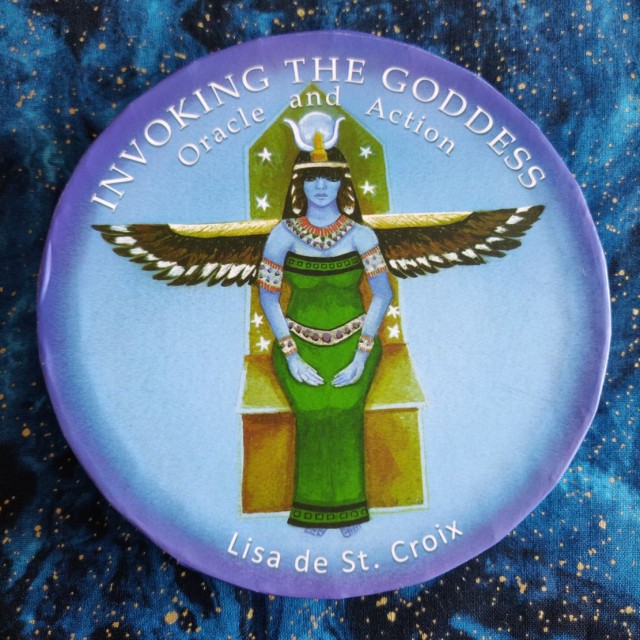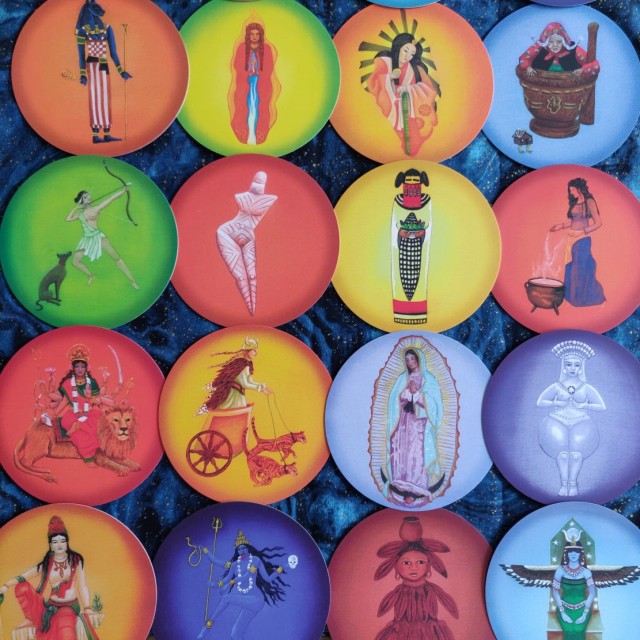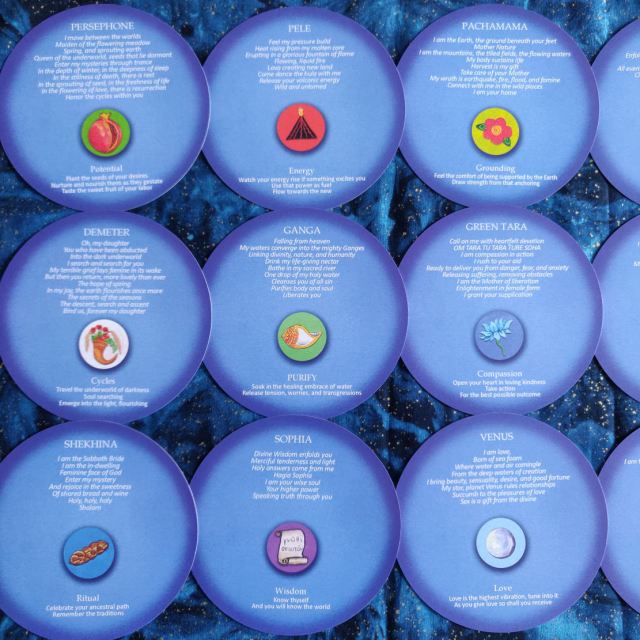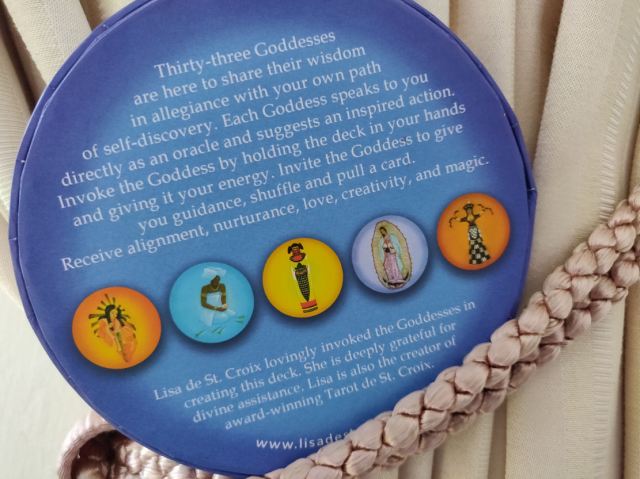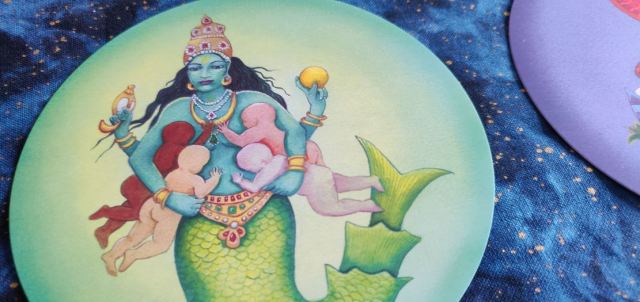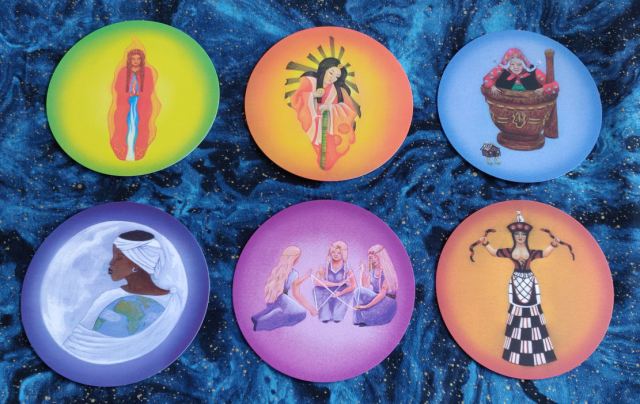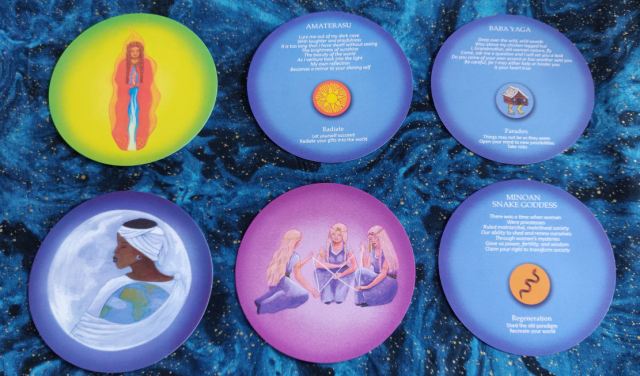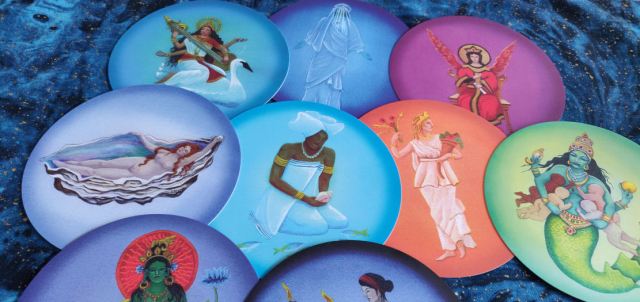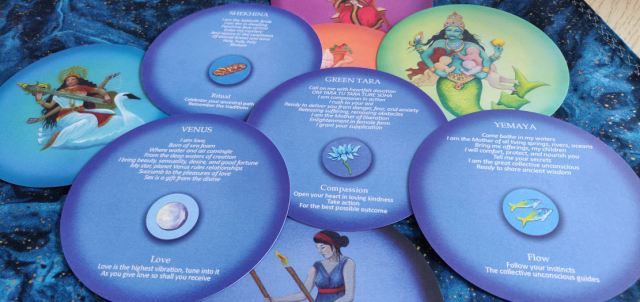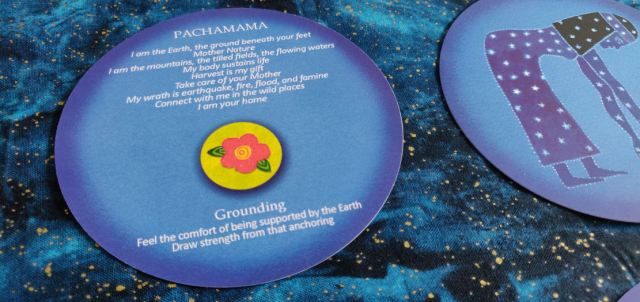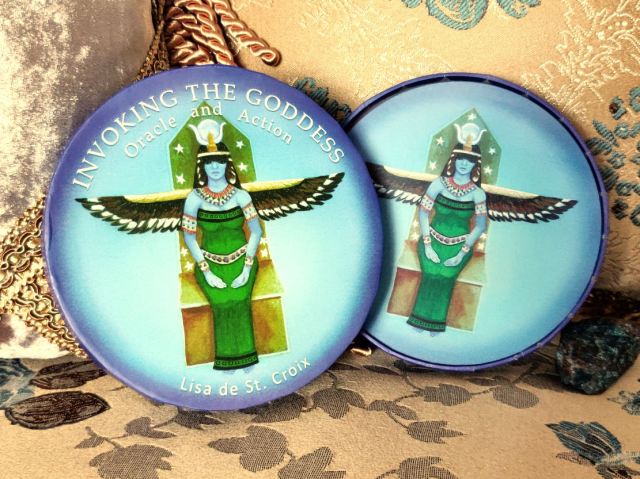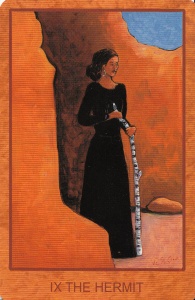Goddess oracle decks have been enjoying a resurgence in popularity as of late, coinciding with what feels like a global, collective acknowledgement of the divine feminine. Some of them have missed the mark, with
cries from the community about cultural appropriation [also
watch here and
another here] but
Invoking the Goddess is one done right, and as powerful as it is beautiful, a model to be followed.
The oracle cards are double-sided, so the way I work with them is by closing my eyes while I shuffle, and pulling a card without looking.
This isn’t one of those decks where you set a spread of 20 cards or sling it out into a Celtic Cross, no. The energy of the deck is palpable, and all you need is to draw one.
Hold the deck in both palms, close your eyes, shuffle, and as you shuffle, visualize your question converting to energy and push that energy out your hands and into the cards.
When you feel ready, pull a card, open your eyes, and connect to the imagery of the goddess.
The diverse representation of multiple pantheons and traditions is beautifully and reverently done. On the text side of each card, one key symbol associated with the goddess is pictured, along with a call to action, addressed to you, straight from that goddess.
There’s a raw spirit to the art on this deck, and I love how natural it feels. A lot of the goddess oracle decks on the market right now rely heavily on digital photo editing, high production, and digital manipulation. So I’m deeply appreciative of the natural beauty here.
Although the deck does not come with a guidebook, you don’t need one. Everything you need is printed right there on the text side of the cards.
The bold coloring and the circular card shape that reminds me of chakra wheels does something to my consciousness when I work with this deck.
Combining artistry and metaphysical knowledge, Lisa de St. Croix has really calibrated this deck for goddess invocation. It’s quite impressive.
Among cartomancers, circle decks can be contentious. Some love them and others turn their noses up at the thought of them. For me, it depends. They can feel more novelty than practical if it’s a tarot deck, but here for the Invoking the Goddess, once I’ve seen it as a circle deck, I can’t imagine it any other way. This deck had to be made this way. It’s perfect for the concept.
The circle cards come to life in your hand. It’s got its own unique energetic imprint, and you almost can’t deny that it’s there. Whereas some of the more commercialized and high-production-value goddess oracle decks that I’ve handled don’t come to life in your hands with that kind of energy.
If you’ve been wondering how you can integrate your spirituality into your everyday life, get Invoking the Goddess Oracle and Action.
The divine call to action on each card gives you a starting point that guides your state of mind and spiritual practice.
You can hear the voice of Spirit through the poetic verses on the cards, which also help to introduce you to the energies and powers associated with that particular goddess.
For professional tarot readers, pulling a single card from Invoking the Goddess to round out a reading session gives your client a sense of divine protection, and also a direction of spiritual practice to go in.
So much guidance is offered in these cards. They add that deepened layer of meaning and divine connection to a divinatory reading.
The cardstock is around 300 to 330 gsm. I would have preferred a much heavier cardstock for a goddess oracle guidance deck, even going up to 400 gsm, but that’s a personal preference. Some may prefer the thinner cardstock for easier shuffling.
Oh, and the cards come in a circle-shaped box! That’s so cool! They’re just the most beautiful deck of cards to keep out on a coffee table or to the side of your work space.
I’ve been pulling cards for friends and family from the Invoking the Goddess Oracle and Action by Lisa de St. Croix and everyone has remarked about how resonant readings with the deck is. There’s a nurturing energy to Invoking the Goddess, a soft yet powerful presence, and it feels maternal. Absolutely beautiful. Highly recommend that you take a closer look at this deck and consider it for your collection.
The Tarot de St. Croix

The Tarot de St. Croix was first published in 2014, distributed by Devera Publishing, and a second edition has just come out this year. It comes in a beautiful full-lid lift top glossy box of high quality and the cardstock quality is great. Love that the accompanying guidebook fits inside the box and contains a wealth of tarot card meaning insights, many that would add to your compendium of tarot knowledge. The guidebook here is not just a rehash of the same old card meanings. There is a lot here specific to the symbolism on the deck and how that symbolism and manifestation exemplifies the traditional card meaning.
When left to my own
devices, I’m not a very colorful person. Orange
is usually too bright for me. However, the color orange stimulates the sacral
chakra, the source of your personal vitality. A strong sacral chakra means
strong personal vitality, which can be used to heal yourself and to heal
others. I also tend to associate the sacral chakra with shamanic journeying.
These themes come together harmoniously in the Tarot de St. Croix, and enables the
deck for powerful healing work. When using tarot for healing, both emotional
and psychic healing, reach for the Tarot de St.
Croix.
The Hermit with its Virgo correspondence has always had a soft,
feminine, wise-woman vibe to me, and I love that the imagery for Key IX in this
deck captures that imagining perfectly. I love the mermaid and angel coming
together in the Wheel of Fortune, or how the Death card is a skeleton floating
toward the Light, through the spiritual tunnel.
Earlier I remarked how the companion guidebook for this deck
isn’t just a rehash of trite tarot card meanings. Here I’ll give you an
example. The Sun card in the deck is dominant with sunflower symbolism. Per the
companion guidebook, sunflower symbolism is about receiving light, growing, and
then manifesting fruition, to in turn give life back and nourish future life.
You take from the light to nourish yourself so that you can grow and later
return the favor and nourish others, to continue that cycle of life. Thus, The
Sun card is about radiating our self-confidence and talents out into the world
at large. I love that meaning for The Sun.
The card imagery feels like channeled visions. You get the sense
that while the work is that of the artist, the idea was implanted into her from
the great beyond. You feel as if you are catching glimpses into other worlds
and multiverses, and given universal depictions for each of the 78 ideas
revealed by the tarot.
I
love the inclusion of all cultures, the mysticism from many heritages, and how
easily and effortlessly you can tell stories as divination to a seeker when
using the Tarot de St. Croix. If you are visual-oriented or
right-brained, creative or artsy, you are going to love reading with this deck.
It also feels like an incredible deck for pathworking. You get
the sense of astral travel here, where the deck creator has gone beyond,
observed what is reality but not reality, and has come back to reveal to us
those observations, through her incredible art.
By the way, I love the tea leaf reading metaphor for the Seven
of Cups. Or the mime juggling the swords under a waning crescent moon for the
Seven of Swords. For those familiar with the 78 card meanings in the
Rider-Waite-Smith system, take your time to go through each card imagery and
study this artist’s interpretation of that card. It’s just incredible. Card
after card, you accumulate this realization that you’re looking at brilliance.
There is a deeply spiritual and mystical dimension to the Tarot de St. Croix that I, sadly, find lacking in
so many contemporary decks.
The
card backs are reversible, again with the orange border, and here we see just
this incredible glimpse into a different dimension or galaxy, slightly
reminiscent of the dark and light pillars you find in the classic High
Priestess card.
The Tarot de St.
Croix is a
brilliant blend of old world and modern mythology, seamlessly weaving together
the many cultures and heritages of our world, to present a united mosaic of
spirituality that transcends both time and space. It’s an ideal deck for
personal healing and for readers to use in psychic healing or energy clearings
for their clients. If you’re working through shamanic journeying practices with
the tarot from my Tarot as a Tool for Craft online course, I’d say the Tarot de St. Croix is one of those perfect decks
to use for that particular practice.
“Tarot de St. Croix” is a 78 card deck that comes with an accompanying 96 page booklet, both enclosed in a sturdy box with a lift-off top. The box is in the same lovely orange that dominates the deck, with a scan of the Sun on the cover, and smaller card images running along three sides. It is structured along traditional lines, using traditional titles for the Major Arcana, with Strength as VIII and Justice as XI. The suits are Wands, Cups, Swords, and Pentacles, with the Court Cards as Page, Knight, Queen and King.
Note: I am proud to say that this deck was published through Devera Publishing, an independent publishing house in Portland, Oregon.
In her introduction, Lisa talks about this deck as being both contemporary and multi-cultural. Inspiration came from current events, personal experiences, mythology, and synchronicity. Lisa describes the Tarot as a visual encyclopedia to the soul.
Lisa’s introduction to the Tarot came from accompanying her mother to a Tarot reading in Johannesburg, South Africa. Some time after her mother’s death the Marseille deck that her mother had purchased at that reading came into her hands, and she began her study of the Tarot. At this time, Lisa was living near a Zuni Indian reservation. At the winter solstice Lisa took a shamanic journey, where Isis instructed her to paint a Tarot deck. She painted this deck as if it were a Tarot reading, and she were receiving wisdom. The introduction also includes thoughts on reading the cards, drawing a daily card, Tarot journaling, a three card spread, a five card spread, and a nine card spread.
While the commentary in the booklet is minimal, Lisa does have a blog where she expands on the card meanings, sharing what they are to her, and her experiences as she was painting each card. It is well worth checking out her blog. The companion booklet shares Lisa’s life experiences, and her philosophy.
The Major Arcana are presented as a two page spread, with commentary on the left hand page, and the card meaning, along with a ¾ page color image on the right hand page. In the commentary Lisa talks about what inspired her for the card, and bits of her own life experience.
The Fool
The Fool is both the beginning and the end of the Major Arcana in the archetypal journey of the soul.
The Fool is inspired by the Pueblo Indian sacred clown Koshare. He wears the mask of Coyote, the trickster. He represents a playful way to look at a situation. The Fool makes a shadow puppet scene of danger. The message is to look beyond our fears to see what really lies behind it. The path leads towards the full moon which symbolizes the cyclical nature of life. The boat represents a journey into the mystery. The Fool’s knapsack lays open in front of him, what will he take with him? The aspen stick with eyes symbolizes the witness and the wisdom gained on his journey.
I lived for a number of years on the Zuni Indian Reservation, where I was fortunate to see their ceremonial dances. One evening as I stood on the rooftop watching the dances below, a Koshare, the sacred clown climbed up the ladder and tricked me into buying a plastic turquoise necklace for twenty dollars, the crowd roared with laughter. I felt embarrassed but also delighted to play the fool n their ceremony. I treasure that necklace, it reminds me to laugh at myself.
The Minor Arcana pips (numbered cards) are presented as groups – i.e. Ace’s together, two’s together et cetera. There is short commentary on what each number means, followed by the number in each suit, a short commentary, and its meaning. Small color scans for each of the four cards appear at the bottom of the page.
Aces
Aces offer the potential of something new that will succeed. Aces are linked to the Magician, the great manifester.
Ace of Pentacles
The full blooming sunflower against the brilliant sky is an expression of abundance.
Meaning – Begin a new project with confidence knowing that it will grow to its fullest potential and flourish.
The Court Cards are presented as groups – Pages, Knights, Queens, and Kings. A full page is given to each card, with commentary about the card at the top, a full color scan in the middle, and the meaning at the bottom.
Page of Cups
This young Page dreamily looks at the water cupped in her hands, imagining romance. She is sensitive and vulnerable as she sits on the lotus, nestled between the stamens.
Meaning: In order to blossom in love and relationships it is necessary to expose tenderness and vulnerability.
The backs show a ¼” orange border, surrounding a mirror image of clouds, the moon, and a figure. The card backs are reversible – and they really draw one in! The cards are 3” by 4.5”, sturdy and semi-gloss. The card faces show a ¼” orange border surrounding a central image. For the Major Arcana, the card number (in Roman numerals) and title run across the bottom of the card. For the Court Cards, the title and suit run across the bottom of the card. For the Minor Arcana Pips (numbered cards), the number and suit, all in text, run across the bottom of the card.
The colors in this deck – predominately orange, yellow, and gold – are intense, vibrant, and absolutely command your attention! This is a very personal deck for Lisa, not only that she was instructed to paint it while on a shamanic journey, but that it reflects her thoughts, her travels, her early years spent in South Africa, and her meditative practices. I purchased this deck while I was at NWTS (Northwest Tarot Symposium). At this time, Lisa was in India meditating and painting … very reflective of the life of this deck.
Queen of Pentacles: The Queen Sheba is carried on a gold palanquin, surrounded by the riches of the earth (ripe fruit, fragrant flowers, and abundant herbs). She embodies the qualities of abundance, nurturing, and generosity. “Meaning – Enjoy the senses, and share with others.”
Knight of Cups: This Knight welcomes the flow of feelings. Lisa notes that her son has always followed his heart, and as a result he has been able to make his dreams come true. “Meaning – A person who acts from the heart.”
The Empress: As the great mother, the Empress nurtures and provides. Her rule is through love. This painting was begun on the spring equinox. As she painted this card, Lisa watched the blossoms on the tree across from her studio open, and the bulbs flower. “Meaning – If we open ourselves to what we need and give and receive love, abundance will flow.”
Ace of Swords: “The wisp of smoke at the end of the sword suggests that something is smoldering, ready to ignite. The new moon suggests the beginning of a new phase that will develop.” “Meaning – Innovative ideas will expand bringing clarity and wisdom.”
The World: “The World is the culmination of the Tarot archetypal journey, it speaks of wholeness and numinous revelation.” “Meaning – The World shows you that you are connected to all that is.”
The Hermit: “The Hermit spends time alone in contemplation. The Hermit is an ally when it comes to dealing with shadow. Look within, and let it be illuminated. Questions will be resolved.” “Meaning – The Hermit invites you to spend time alone to allow your inner wisdom to reveal itself.”
Three of Wands: “The Mother watches her progeny’s boat come in. Three wands blossom with the promise of success. The figurehead leads the boat towards the spirit world. “Meaning – Visionary leadership will see a project flourish.”
The Magician: “The Magician uses will, the elements and Spirit to manifest that which is desired.” “Meaning – The message of the Magician is that through focused energy we are able to harness the means to create our destiny.”
Seven of Pentacles: “The girl in the leopard skin reaches eagerly towards many projects.” “Meaning – Pause and evaluate your goals, before unleashing energy to achieve them.”
I am impressed with this deck to the point that I am in awe! The vibrant colors draw the reader in and make them feel at home – warm and protected. There is a very sacred feel to these cards, partially because of the archetype that the Tarot is, and partially because Lisa has shared so much of herself and her sacred life journey with the reader. I highly recommend that the reader make best use of Lisa’s blog, where she goes in-depth into what the cards mean to her, and where she was in her journey when she painted them.
Lisa has placed herself in some of the cards along the way, and has included other individuals from her life. Quite an interesting card is the Page of Swords, which integrates her son drawing the golden mean on a blackboard with a sword. A subtle way if showing that the golden mean is at work in this deck. This is a comfortable deck for all levels of Tarot student, and certainly what one could term a “teaching deck”.
© 2015 Bonnie Cehovet
Tarot de St. Croix by Eric
Lerner
The Tarot de St. Croix is a handsomely produced deck
published through Devera Publishing by artist and tarot reader Lisa St. Croix.
It is a full 78 card deck that follows Rider-Waite numeration (Strength is 8,
Justice 11.) Its impact is achieved through the artist’s decidedly warm color
palette, multi-cultural and personal iconography, visual nods to Rider-Waite
and use of sacred geometry. Overall it is well thought out and decidedly
reflects St. Croix’s original point of view.
The first thing that jumps out at you is her vibrant use of
oranges, golds and yellows in many of her compositions. This serves to invite
the viewer into the visual worlds depicted. At times I found that the use of
these hues in the border design took focus from the actual images (perhaps a
neutral colored border would have helped them pop more.) Overall this color
scheme makes the cards inviting.

St. Croix uses that to draw
the reader into her personal universe, in no small part shaped by her extensive
travels and meditations on diverse cultures. This does not confuse the overall
philosophical narrative of her exploration, and it is nicely balanced with
frequent nods to her biography and family. She explains her journey in the
accompanying booklet. For instance, in the Fool, she incorporates the trickster
figure of Koshara. She had spent years living on Zuni reservation where she
encountered him in traditional dances. “One evening,” she writes, “ as I stood
on the rooftop watching the dances below, a Koshare, the sacred clown, climbed
up on the ladder and tricked me into buying a plastic turquoise necklace for
twenty dollars, the crowd roared with laughter. I felt embarrassed but also
delighted to play the fool in their ceremony. I
treasure that necklace because it reminds me to laugh at myself.” Her
personal intimacy with the figures from other cultures here doesn't make their
incorporation come across as a gimmick or non-sequitur as they do in some other
contemporary tarot.
She balances the global display by including family members
and nods to the Rider-Waite Tarot in the tarots. Significantly she uses the
later references to clarify her own personal vision rather than simply recast a
deck with which most readers are well acquainted. In the Suit of Swords there
are many takes suggested by Pamela Colman Smith’s art. Among the more obvious
of these are the blindfolded female figure in the Two and the thrice-impaled
heart in the Three. Yet she doesn't adhere to Waite’s interpretation of the
cards and provides visual clues in the artwork itself. For instance in the
Three, she crowns the heart with flames. The fire is not destructive, but
warming, and contrasts the raining clouds depicted in the earlier rendition. St. Croix stresses: “The flaming heart represents
passion. Three needles pierce the heart but one is mending a broken heart.
Meaning: Forgiveness heals betrayal and heartbreak.” Most decks, including Rider-Waite, offer much
more dire interpretations. St. Croix further
develops her own take on life through the later numbers in the Suit of Swords
that play off and contrast Rider-Waite and move inextricably in an original
direction.St. Croix
depicts a female figure both face up and down, balanced by the swords like an
exquisitely balanced shaman walking uninjured upon nails against a night sky.
She writes: “This is the end of worn out
ways of thinking. We can rise above the old, unhealthy victim mentality,
supported by the lessons learned.” She works from pre-established iconography
and pushes forward from it.

In 10, we are familiar with the image of an impaled figure and the
desolation and pain it indicates. Instead, St. Croix does not include
reversed definitions like Waite or elemental dignities in her definitions or
take on reading. Even when the cards themselves indicate challenges, they also
indicate solutions. The innovation here is that typically as readers we look to
other cards in a spread to indicate how to resolve “problem” cards. St. Croix indicates solutions in the context of the cards
themselves. It makes her deck useful for one-card readings. Also in her
nine-card spread, Nine Temples of the Soul, the placement of the elements is
predetermined by the spread itself with positions for majors, each suit and
court figures. Hence the meanings of the individual cards are not subject to
the permutations of their sequence so much as they relate to the specific areas
of unique life endeavor.
 Another noteworthy feature of the deck is the artistic use
of sacred geometry, most significantly St. Croix
reliance on Golden Mean ratios in composition. In short, a golden ratio is
achieved by two spaces when their ration to one another is the same the larger
body is to the sum. It is felt that this type of proportion creates a golden
mean of visual harmony. Numerically it is it roughly 1.62, phi. Artists create
both pleasing visual compositions and indicate idealized states through its
spatial geometry. Since many of us have developed subconscious familiarity with
it through frequent exposure, an artist can use it to help a viewer interpret
her work. St. Croix makes direct reference to
this in the Page her Swords by depicting her son Simon as a blackboard hero
rendering a golden mean ratio.
Another noteworthy feature of the deck is the artistic use
of sacred geometry, most significantly St. Croix
reliance on Golden Mean ratios in composition. In short, a golden ratio is
achieved by two spaces when their ration to one another is the same the larger
body is to the sum. It is felt that this type of proportion creates a golden
mean of visual harmony. Numerically it is it roughly 1.62, phi. Artists create
both pleasing visual compositions and indicate idealized states through its
spatial geometry. Since many of us have developed subconscious familiarity with
it through frequent exposure, an artist can use it to help a viewer interpret
her work. St. Croix makes direct reference to
this in the Page her Swords by depicting her son Simon as a blackboard hero
rendering a golden mean ratio.
Not only is this an affection nod to both her family and
technique, it provides us with a map for how we may wish to examine her
imagery. I found her use of golden mean proportion most pleasing when she uses
it to create dynamic compositions such as in the family drama of the Five of
Swords or exuberant Nine of cups. Our gaze moves through them in a kinetic way
making the situations come alive. One of the pratfalls of using sacred geometry
consistently in compositions is that they can become too static looking. Very
often tarot decks that rely on sacred geometry become a series of strategically
placed glyphs that one may need a guide to decipher. St.
Croix’s images tend toward emotional immediacy.
Overall, St. Croix has done
a fine job of producing a deck that is at the same time personal and integrated
with the world as a whole, acknowledging also the artistic and divinatory
traditions in which she works. Tarot de St. Croix can also work well as
someone’s first reading deck, given its visual clarity and warmth. It succeeds
on many levels and offers and optimistic and inspiring philosophy toward life.
Eric Lerner www.radiantspleen.com
Review of Tarot de St. Croix by Wray Dansereau
Joanna Powell Colbert
Conversations with Creatives –
An Interview with Lisa de St. Croix
I met Lisa de St. Croix online a few years ago through mutual friends in the tarot community. I loved the vibrant colors of the deck she was working on. We met in person when I visited New Mexico in 2011, and I've had the pleasure of being a guest in her beautiful Santa Fe home.
Now the deck is finished and out in the world, and it’s a beauty. I adore the lush colors, the vibrant New Mexico landscape, and the mix of mythic and contemporary imagery.
As an artist and deck creator myself, I love having conversations about the inspiration and creative process behind projects like this one. Listen in while I ask Lisa about the Tarot de St. Croix!
Conversation with Lisa about the Tarot de St. Croix
.JPC: What is the story behind this deck? Where did the initial idea come from?
LdSC: On the winter solstice five years ago I did a shamanic journey. I travelled to a small black and white temple in the Upper World. On the throne lay a tarot card of the High Priestess: Isis. She instructed me to paint a tarot deck. Shortly after the journey I began painting Tarot de St. Croix
JPC: Tell us about your intuitive process for choosing a card to paint, and how the meaning of the card was mirrored in your personal life.
LdSC: I painted this tarot deck as if it where a tarot reading: receiving divine wisdom. Each time I pulled a card to paint I was amazed how perfectly the meaning of the card related to the world I inhabit. I opened my senses to messages. Synchronicity was my guide. I painted intuitively, having faith that I would convey through the visual medium of the tarot, a message that would have meaning and wisdom.
The first card I painted was the Nine of Pentacles. I painted what I hoped to harvest in my life: a home of my own a garden filled with flowers and water. I painted a falcon sitting on my shoulder. I now am in that home, with a view of the Santa Fe mountains, a fountain and sunflowers and a falcon visits on occasion!
JPC: I know there are scenes from Santa Fe in the deck, as well self-portraits and portraits of the people in your life. Can you tell us about a few of those cards?
LdSC: For the Five of Pentacles I painted a scene I see often in Santa Fe that creates much anxiety for me. Outside the Sanctuario de Guadalupe, there are always a group of day laborers waiting in all extremes of weather, hoping to be hired. There is a feeling of desperation, as they try to flag down passing cars. While working on the painting I reflected on the loss I was experiencing at the time; it was my deceased mother’s birthday and I miss her. As I painted the giant statue of Guadalupe behind the men I realized that the archetype of the Great Mother is always there for us when we need her. She in her thousand manifestations, watches over us.
I appear in several of the cards as my experiences while painting the deck were so filled with wonder and magic I just had to record them. In the Nine of Cups I raise my cup in a toast to my new home, the one I had wished for in the Nine of Pentacles and in gratitude to the Powers that Be that had blessed me with it.
My sons Noah and Simon appear as two young Pages. My lover Tony joins me in the Two of Cups, the Lovers and is the Chariot, helping me move this deck from paintings into card format. Friends and family also take residence: my father the King of Cups, my brother the Four of Cups and my dear friend Duija as the Queen of Cups.
JPC: Tell us a little bit about your background as a painter, and about the medium you use (oil paints). Why oil and not another medium?
LdSC: I studied art at the School of Visual Arts in New York. My paintings have been exhibited in galleries and non-profit spaces in New York, Santa Fe, Boston and across the USA and in several international exhibitions in South Africa, Portugal, France and Mexico. I live in Santa Fe, New Mexico where I paint and teach a variety of art workshops in my studio.
Oil paint over a venetian red gesso background is the medium I have used for several years. I wanted to make this deck feel more like paintings than illustrations. I love the rich luminosity and vivid colors that oils give.
Lisa was working on this card, the 8 of Pentacles, when I visited her in August 2013.
JPC: What was the publishing process like?
LdSC: I ran an Indiegogo crowd-funding campaign to raise money for printing and was thrilled that I raised $6,677.00. I offered a deck in return for support. I am extremely grateful to Devera Publishing who assisted me in self-publishing this deck.
JPC: How do you personally use this deck, in your own spiritual practice?
LdSC: I pull a card everyday as a meditation. When I have a specific question I do a reading for myself. I have also really been enjoying doing readings for others, seeing my deck come alive and be of service to people.
JPC: What do you most want people to know about this deck?
LdSC: There is a full color booklet of meanings and spreads included in the box. However I think the images which are unique, carry the essence of the archetypes and are easy to understand visually. It is a multi-cultural deck that embraces all of humanity in our many experiences.
JPC: What’s up next for you?
LdSC: While working on this deck I kept a visual journal – I would love to publish it as a kind of workbook. I also have a “Natural Wisdom” oracle deck of animals and plants that created a number of years ago, I would like to add to and publish it.
Tarot de St. Croix by Lisa de St. Croix

Tarot
de St. Croix © 2013
* Available - March 2014
* 78-Card Deck & Book, Boxed Set
* Major Arcana: Roman Numerals & Traditional Titles
* Strength is Card VIII and Justice, XI
* Traditional Suits: Wands, Cups, Swords & Pentacles
* Court Cards: Page, Knight, Queen & King
* Cardstock: Semi-Gloss, Standard Thickness (300 gsm)
* Card Back Design: Mirror Image - Reversible
* Card Size: 3" x 4.5" (7.6 x 11.4 cm)
* Art Medium: Original Oil Paintings on Boards
* 96-Page, Soft-Cover Booklet, Full-Color
* Comes in Sturdy 2-Piece Box
* Self -Published with Indie Publishing House - Devera - Spring 2014
* ISBN: 978-0-9858321-9-3
 The eagerly awaited Tarot de St.
Croix has arrived to dust off winter blues, with its sunny
disposition and warm invitation to become immersed in splendor. This is a
deck which expresses all manner of emotion while sharing experiences of a
multi-dimensional and well traveled existence. A beautifully made personal
offering which will translate well to all those who are open to its vision.
And well done to Devera, the metaphysical
publishing house in Portland, Oregon;
which prides itself on shepherding each independent artist and project with
practical know-how, support and attention to detail. The eagerly awaited Tarot de St.
Croix has arrived to dust off winter blues, with its sunny
disposition and warm invitation to become immersed in splendor. This is a
deck which expresses all manner of emotion while sharing experiences of a
multi-dimensional and well traveled existence. A beautifully made personal
offering which will translate well to all those who are open to its vision.
And well done to Devera, the metaphysical
publishing house in Portland, Oregon;
which prides itself on shepherding each independent artist and project with
practical know-how, support and attention to detail.
The semi-gloss cards are a decent size and thickness, comfortable for
shuffling. While the sturdy, brightly colored, two-piece box makes a great
presentation; displaying nineteen cards, with the brilliant XIX Sun on top
(shown above). The imagery has a welcoming vibe, with amber colored borders
and cheerful (san serif) titles in a matching hue. The back side of the
cards has a mirror image and is therefore reversible. Much of the artwork in the cards feels at once personal yet universal;
powerful though unarmored; bold but sensitive and sincere. Lisa's likeness
(along with key people in her life) can be found throughout the deck,
making it apparent that she has lived through these 78 cards with their
associated lessons, trials and tribulations while comprehending their
implications. The artwork is consistently lovely and inherently symbolic.
The 96-page, soft covered book is a nice companion to the deck. Both are
the same: 3"x 4.5" - 7.6 x 11.4 cm and fit snuggly in the box.
This full color booklet is presented with thoughtful consideration; sharing
the artist's experiences with the card meanings along with words of insight
or practical wisdom to carry into one's own reading or meditation. Those
familiar with the Waite-Smith template will feel at home here. In the
introduction section Lisa shares three Tarot reading spreads as well as
tips on one-card readings and hints on how to work with this deck including
journaling.
Each Major Arcana has two pages dedicated to
it; with the (color) card image taking up nearly half of one page. Lisa
often shares a personal story surrounding the Trump that is meant to
inspire or reveal a life lesson. She then includes a brief, more general
meaning for the card.
Next, each set of Minor Arcana in the four suits are spread over a two page
layout (Minor card images presented smaller than the Majors). So for
example, the four Aces (in the order of: Cups, Pentacles, Swords and Wands)
have short symbolic and personal descriptions along with general card
meanings for the individual Aces. An overall numerological meaning is given
above the four card series thusly:
Aces offer the potential of something new that will succeed. Aces are
linked to the Magician; the great manifester.
The Court cards follow next; in the order of the four: Pages, Knights, Queens and Kings. Each Court card has its own page in
the book, which includes a good-sized image and personal associations along
with a succinct interpretive meaning.

There is enough guidance in the booklet to be helpful to the novice while
respecting one's own personal associations and process. It should be noted
that the book doesn't tend to share reversed card meanings except as
associated with personally challenging experiences. For example, the Three
of Swords (which most view as the card of heartache, sorrow and
betrayal); Lisa describes in a more positive light. She writes:
The flaming heart represents passion. Three needles pierce the heart but
one is mending the broken heart.
Meaning: Forgiveness heals betrayal and heartbreak.
For those who like to put a positive spin on things this approach may be
appealing. Though one might suspect that Lisa opted for briefer passages to
keep the booklet compact and easy to decipher when doing readings. The
pages are unnumbered but its easy to find any card meaning since the images
are presented in a systematic order and also act as colorful flags. It
should also be noted that Lisa goes into much more detail about each card
on her Blog. There she often shared what the card represented to her at the
time of creation and sometimes what she was actually going through during
its inception. Therefore one can find the artist grappling with darker,
deeper elements of many of these cards. In the case of this Three of
Swords she candidly writes on her Blog of a sorrowful experience with a
significant relationship; which she is able to work through with this quasi
'art therapy' process and eventually transcend the heartbreak. In essence,
the book shares more of the positive learning aspects associated with the
outcome than the personal struggles that lead up to it. So if one is
interested in understanding these cards more deeply; it is recommended to
peruse Lisa's Blog posts. For
example, a personal favorite image in this deck is Lisa's Three of Cups.
On her Blog, Lisa reveals the card's personal associations:

The Three of Cups is a card about friendship and the emotional
bonds between people.
On the solstices, equinoxes and cross quarter days; we three meet to play
The Tarot Game. We have created a ritual around it. The game involves
asking the oracle a question and then the oracle has us tell stories from
our lives relating to the tarot archetypes. This gives us the opportunity
to talk deeply about our lives and be heard. Answers to our question arrive
through this sharing.
But due to space limitations (one assumes), in the booklet this passage
is reduced simply to:
Three friends gather to play the tarot game, whilst sharing stories.
Meaning: Cherish friendship and emotional bonds with people.
While it is a positive message connected with this card; the more detailed
Blog entry recalls such warm, evocative times with friends...and a more
meaningful association.
Having watched this deck evolve and grow online along with a community of
supportive Tarotists; while enjoying the creative process and camaraderie
surrounding the development of each deeply felt card and experience, it was
touching to witness the artist's soulful journey within the nurturing
embrace of her facebook friends. She moved through the deck, making each
card in a ritualistic, sacred manner; while being open to whatever messages
might arise. She candidly shares of her introduction to Tarot and her creative
process while making this deck:
When I was a child of eleven in South
Africa, I accompanied my mother to get a reading from
a tarot reader on the other side of Johannesburg.
As I waited on the wide verandah, I thought about destiny, about wisdom and
faith. These were new concepts for me and I was taken by them. The
predictions of that tarot reader came to pass; within a year my mother
divorced, fell in love with a foreigner and left to live with her new husband
on the Mediterranean Sea. Many years later after my mother had died,
through a mysterious set of circumstances the old Marseille deck she had
bought from the tarot reader came back to me. I immersed myself in the
study of Tarot. I was living in New
Mexico near the Zuni Indian reservation. On the
winter solstice I did a shamanic journey where I travelled to a small black
and white temple in the Upper World. On the throne lay a tarot card of the
High Priestess: Isis.
She instructed me to paint a tarot deck. I painted this tarot deck as if it
were a tarot reading: receiving divine wisdom. Each time I pulled a card to
paint I was amazed how perfectly the meaning of the card related to the
world I inhabit. I opened my senses to messages. Synchronicity was my
guide. I painted intuitively, having faith that I would convey through the
visual medium of the tarot, a message that would have meaning and wisdom.
Another personal favorite is Lisa's XX Judgment card (shown right).
In the image she portrayed dear friend and mentor Carrie Paris in
the magnificent Cathedral of Siena. As it happens I met both Lisa and
Carrie together during a Tarot Art HYPERLINK "http://www.arnellart.com/tarot-italy-tour2015.htm"&HYPERLINK
"http://www.arnellart.com/tarot-italy-tour2015.htm"
History Tour of Northern Italy , (which I organize and run
along with my husband and our dear friend, Morena Poltronieri - director of
the Italian
Tarot Museum.) So it is especially touching that Lisa shared
a part of the Italy tour experience here; giving a much more impactful and
gratifying meaning to a card that tends to be challenging to many Tarotists
(including myself). Lisa shared details about this Judgement card on her
Blog.

Judgement:
Just having returned from the Tarot Art and History Tour of Northern Italy, I felt inspired to integrate some of
the symbolism I had seen into my Judgement card. I was intrigued by the
mosaic floor in the Siena Duomo. We were lucky
to see it unveiled as only once a year are the floors uncovered. Pagan and
Tarot imagery are everywhere. Hermes Trismegistus greets one at the
entrance to the magnificent Cathedral. Ten large mosaics of Sibyls line the
two sides. The Sibyls are women who prophesize. We found symbolism used in
the World, Chariot and Wheel of Fortune tarot cards in other panels.
One of the original meanings to this card was "Judgement Day" so
I contemplated what that might mean now to the people who read tarot.
Fundamentally I think that what we believe is what we receive. To the
innocent child twirling in a beam of sunlight, there is no elaborate morality,
just the purity of the moment, connected to all that is. Under the child's
feet spins the Wheel of Fortune.
Judgement as an act of discernment is another meaning. As I visited these
Catholic Cathedrals I felt waves of judgement roll through me; both awe at
the mastery of the artists and artisans and horror at the sacrifices, the
cruelty and domination of the church. The man in the background of my
painting kneels praying to the Archangels. Does he fear their judgement or
is he bowing to their beauty and grace?
Another meaning of Judgement is an awakening, the call of the soul to a new
paradigm. In front, standing beside the Sibyl is my dear friend and teacher
Carrie Paris who I shared the tour with. I witnessed one of her teachings
made real as she entered the "Fourth Level of Understanding: The
Sacred Gaze". Like the Sibyls, we tarot tribe have faith in the
prophetic messages that come to us through divining.
The Judgement card asks you to look at your beliefs and decide if they work
for you, opening yourself to the possibility of another way of believing.
Tarot de St. Croix is a powerfully expressive, yet warmly accessible
deck; made by an artist who shares deeply of her inner and outer spiritual
realms. This deck is recommended for Tarot readers, both beginners and
advanced, and for collectors; especially those who appreciate uplifting,
life affirming meditations with the cards. This deck set became available
March 2014, and can be obtained directly from Lisa de St. Croix's website or
on this page from Devera
Publishing.

With Tarot de St. Croix, Lisa imparts to the spiritual traveler her
personal experiences while navigating these ancient, sacred paths which we
share. This hand painted deck is a colorful, dazzling, multi-faceted gem
and her story will touch those who journey with her powerful work. Good
medicine for the weary soul and inspiration for those seeking a kindred
spirit!”
- Arnell
Ando
|
Lisa de St. Croix was born in Johannesburg, South Africa.
She received a Bachelor of Fine Arts from the School of Visual Arts in New York. Lisa has exhibited paintings in New York, Boston,
Santa Fe and
many other places in the U.S. She has also
held international exhibitions in South Africa, France, Portugal and Mexico.
She was awarded the New Mexico Arts Purchase Award twice. Her paintings are
in many private and public collections. Ms. de St. Croix's artwork hangs in
several hospitals, as well as the Corrales Court House and the New
Mexico University.
Lisa has taught many art workshops throughout the world. She has designed
sets, written and produced puppet shows and painted several murals on public
buildings. Her paintings and art journals are inspired by her experiences,
travels and shamanic journeys. She now lives in Santa Fe,
New Mexico where
she teaches art workshops. This self-published deck set became available in
early spring of 2014. Lisa shares of her own creative process:
The rich oil paintings of Tarot de St. Croix transcend time to portray the
tapestry of life and the journey of the soul through it. I was inspired by
the world I witness, my visions and synchronicity. My time traveling and
living amongst different cultures is represented in vibrant colors and
symbology. The images hold the energy of the universal archetypes.
|
Tarot de St. Croix - Leslie Cochran
I am blessed
to be in possession of Lisa de St.
Croix's Tarot de St. Croix , a deck of 78 cards, beautifully reproduced
from Lisa's paintings. The boxed set
with booklet and warm toned palette feature her Sun Card - a woman in shadow/silhouette
cupping the sun disk amidst a profusion of sunflowers. This joyful Sun card is a warm and welcoming
prelude for us to settle in and enjoy the journey.
Reading the
booklet and expanded description on Lisa's blog http://lisadestcroix.blogspot.com/
reveals her own creative journey as deeply personal and intuitive. The artist does not shy away from the range
of emotions that naturally surface when immersed in this work. Her gentle yet powerful words describing each
card's meaning, echo the journey we all share.
Along with the seeds of hope and positivity planted in each card - the
message of each, visually and verbally is immediately relatable.
As I walk
through the deck, I am struck by the perfect blend of mystery and clarity. The color palette is cohesive and the warm
golden-hued borders compliment each image.
I can't imagine the task of creating 78 paintings, each a beautiful
story on its own - and have them come together after a long process and still
fit together so well.
I selected four
cards to write about, a hard choice as they all speak to me.
The Moon: a diving woman reaches
into the deep sea to touch the full moon, between the two columns from the High
Priestess card, each column crowned with a pink water lily. A crescent moon
gleams above. It's a beautiful card that shimmers with layers of color and
depth. Lisa writes about a trauma she experienced "There is
something very profound about being so swamped by feeling, I feel surrounded by
spirit."
If we allow ourselves to feel our emotions, instead of drowning in them,
we can come to understanding and healing.
I love the details on this card, the splash where her dive broke the
surface, the air bubbles (which remind me to 'breathe'!) And of course the lovely bright pink water lilies - an unexpected
delight.
The Hanged
Man: Again, we see the many layers that a skilled painter's brush strokes
can achieve, in the sky and clouds and tree bark, and in the Hanged Man. He is made of stars and dark night sky,
suspended in glittering contrast to the dreamy blue twilight sky and drifting
pastel clouds.
Lisa writes on her blog: "
Even though he is back lit by a glowing full moon he is travelling deep into
space to a distant star which ignites his heart. At his third eye is a new
moon, a symbol of potential"
This card speaks about getting new perspective and suggests travel to
the unconscious and shamanic realms. For
those who are interested in exploring the shamanic journey, Lisa's Hanged Man
is a perfect meditative companion.
 Eight of
Wands: This card buzzes and hums with life, but at the same time calls us to
action. In my own backyard as well as in
the theme of this card, hummingbirds and bees perform their joyful dancing
flights seeking nectar and pollen. Lisa
captures the vibrant iridescence of the hummingbird and many busy bees amidst
penstemon stalks. She calls us to action
however, as the bees are dying worldwide now due to our negative impact on the
planet with pesticide use. I so
appreciate this card and the opportunity to shed more light on this issue.
Eight of
Wands: This card buzzes and hums with life, but at the same time calls us to
action. In my own backyard as well as in
the theme of this card, hummingbirds and bees perform their joyful dancing
flights seeking nectar and pollen. Lisa
captures the vibrant iridescence of the hummingbird and many busy bees amidst
penstemon stalks. She calls us to action
however, as the bees are dying worldwide now due to our negative impact on the
planet with pesticide use. I so
appreciate this card and the opportunity to shed more light on this issue.
Eight of
Swords: The raven stands "trapped" in a circle of eight swords in a
vast desert. The mind can be an
effective jailer. That prison cell is
one we walk into ourselves, but it is truly an illusion. As Lisa writes that "Raven is a highly
intelligent bird" and "if we change our mindset, we can step out of the
cage and fly free"
There is that seed
of positivity, a reminder, in this card. In it we can almost see raven going
through that thought process as she/he peaks through the swords at the yellow
desert sands, far hills and endless clear blue skies.
Lisa de St. Croix's Tarot
de St. Croix with its vibrant and soul stirring imagery, would make a
beautiful and empowering gift, and an important addition to your Tarot
Library.
 Another noteworthy feature of the deck is the artistic use
of sacred geometry, most significantly
Another noteworthy feature of the deck is the artistic use
of sacred geometry, most significantly  Eight of
Wands: This card buzzes and hums with life, but at the same time calls us to
action. In my own backyard as well as in
the theme of this card, hummingbirds and bees perform their joyful dancing
flights seeking nectar and pollen. Lisa
captures the vibrant iridescence of the hummingbird and many busy bees amidst
penstemon stalks. She calls us to action
however, as the bees are dying worldwide now due to our negative impact on the
planet with pesticide use. I so
appreciate this card and the opportunity to shed more light on this issue.
Eight of
Wands: This card buzzes and hums with life, but at the same time calls us to
action. In my own backyard as well as in
the theme of this card, hummingbirds and bees perform their joyful dancing
flights seeking nectar and pollen. Lisa
captures the vibrant iridescence of the hummingbird and many busy bees amidst
penstemon stalks. She calls us to action
however, as the bees are dying worldwide now due to our negative impact on the
planet with pesticide use. I so
appreciate this card and the opportunity to shed more light on this issue. 

















